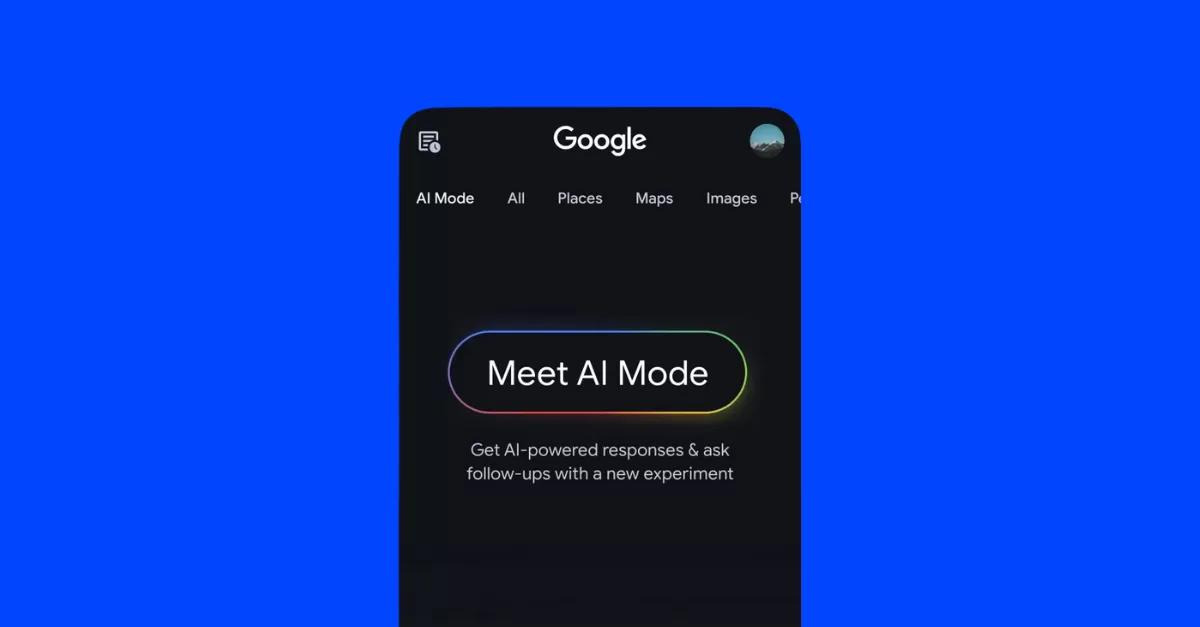Joe Rogan deepfakes. AI-powered drones that follow you around to remind you to pay your parking tickets. And, if you weren’t already scared enough of the AI-induced end of mankind, we now have one more terrifying example to add to this list. Google’s new AI Mode. That’s right. The bots are coming for your organic traffic.
Okay, this isn’t entirely new news. And, as we’ll dive into shortly, it’s not all bad news for business owners and organic search marketers. But the expansion of AI Overviews, which have been impacting search engine results pages (SERPs) for over a year now, is nothing to sneeze at. And with the launch of AI Mode, a more personalized, intuitive, and conversational version of search than anything else Google has created, marketers everywhere need to be informed about what exactly this means for their ability to drive organic traffic from search.
Never fear: we’re here to fill you in. Let’s dive into what AI Mode is, what it means for your organic search efforts, and what you can do to best position yourself for the future.
Contents
What is AI Mode?
To fully understand the implications of AI Mode, we first have to understand what it is. And to get at the root of AI Mode, we need to start with an exploration of AI Overviews. If you’ve used Google at all in the past year, you’ve seen plenty of search results that look like this:

An AI Overview of AI Overviews.
AI Overviews merge the power of Gemini, Google’s largest and most capable AI model, with traditional search. Google introduced AI Overviews as part of its Search Generative Experience (SGE) during the Google I/O conference in May 2023. Initially available in the United States, the feature was officially rebranded as AI Overviews and rolled out globally in October 2024.
AI Overviews essentially populate longer, more in-depth answers to search queries that Google deems deserve them. You’re likely to get an AI Overview for queries that are:
- Broad and informational-based. “How does solar panel efficiency compare by brand?”
- Comparison-based. “Tesla Solar Roof vs. traditional solar panels?”
- Multi-step. “What are the steps to install a standing seam metal roof?”
- Explanatory. “Why is fly fishing better in colder water?”
Per Google, their systems “automatically determine which links appear. There is nothing special for creators to do to be considered other than to follow our regular guidance for appearing in search, as covered in Google Search Essentials.”
We’ll get to whether or not we buy this statement in our section on how to optimize for AI Overviews/AI Mode.
How does AI Mode differ? Well, it takes the conversation a step further. For users who want to have a more in-depth conversation on a topic (rather than just a single question-and-answer), AI Mode brings Gemini’s chat experience into the SERP. All you have to do is click on the icon.


From there, users enter a query just as they would in traditional search. But instead of a one-and-done answer, they now have the ability to take their research a step further using the Ask AI Mode search bar.


This is particularly useful for questions that require more advanced exploration, comparisons, and reasoning. It’s also particularly time-consuming if, like me, you’re addicted to entering research wormholes.
🛑 Want to learn more about search engine marketing on Google? Get the free guide >> PPC 101: Complete Guide to Google Ads
Has AI Mode been fully released?
Not quite. Google first announced AI Mode on March 5 and has been testing and gathering feedback from a trusted sample of users. On March 24, they expanded to a second group of users. That means that if you don’t currently see the “AI Mode” icon next to your search bar, you still need to manually opt-in. You can do that by going to the AI Mode site and opting into Search Labs–that will add you to a waitlist or grant you access.


How does AI Mode change the current landscape of search?
Okay. Now that we have a good handle on what AI Mode is and how users will be engaging with it, let’s get to the good stuff. If, like me, you felt a wave of relief when you read that AI Mode was still constrained to test users and to manual opt-ins, I would suggest you think twice before letting that temporary sense of relief turn into complacency. For me, one paragraph from Google’s blog release was particularly telling:
“AI Mode is rooted in our core quality and ranking systems, and we’re also using novel approaches with the model’s reasoning capabilities to improve factuality. We aim to show an AI-powered response as much as possible, but in cases where we don’t have high confidence in helpfulness and quality, the response will be a set of web search results.”
So here is Google telling us 1) That there’s not much publishers can do to optimize for AI Mode, and 2) That they aim to show an AI-powered response as much as possible. AI Overviews have increased considerably over the course of the past year, and you can bet that Google is going to continue to lean into AI and will soon roll out AI Mode to all users. That means that all the ways people have traditionally gotten to your site through search, things like the list below are going to be folded into one interface:


Naturally, Google anticipated pushback from search marketers who are worried that more AI is going to throttle their traffic. Why go to a website when a user can get all the information they need from a chat module? And it’s a valid concern. But Google is basically saying: If you’re producing quality content, don’t worry about it. Keep doing things the right way and you’ll be rewarded.
🤖 Speaking of AI… Want to use it the right way? Free download >> Emergency Guide to AI in Marketing
How businesses can optimize for AI Mode
To a certain extent, Google is right. They make the products, and they bring in the audience, so we’re all just playing the game based on the rules they set. It’s also true that if you spend too much time worrying about how to deal with various updates in search, you risk neglecting the hard work that leads to genuine results: creating quality content. It’s a platitude, but it’s proven true time and again.
So that’s my first tip for how publishers should prepare for AI Mode. Double down on what you’re doing right. Bring in credible content creators. Create in-depth content that comes from a place of expertise and genuinely solves a pain point. Make sure your Core Web Vitals and UX are strong, and that you’re generating high-authority links. All these things are going to lead to Google popping your link in an AI Overview, rather than your competitors.
That aside, here’s where I think businesses can move the needle in the new landscape of AI:
1. Write content that AI wants to feature
AI responses prioritize concise, authoritative, and structured content. That means you should, ideally and when appropriate, try to answer questions directly in the first 1-2 sentences. Then introduce deeper explanations, examples, and links.
It also means that you should become extremely well-acquainted with lists and tables. Are you writing a blog post on the exorbitant price of vegetables? Fight that urge to wax poetic, in paragraph form, about what the price of vegetables used to be. Instead, do this:


Facetious example, but you get the point. Tables and structured content are easier for Google to interpret and relay to users.
🚀 Free guide >> 10 Tangible & Free Ways to Get on the First Page of Google
2. Own the next step
At a certain point, depending on the query, your user is going to have to leave the SERP to get the information they need. Your job is to own the queries and the content that live in that next step.
Sure, it’s going to get a lot easier for users to get straightforward answers from the SERP that they used to get from your website. But things like case studies, deeply opinionated and data-backed thought-leadership, and deep analysis: these are all areas where you can and should continue to shine.
3. Strengthen E-E-A-T (Expertise, Experience, Authority, Trust)
We talked about credibility a bit earlier, but we really can’t stress enough how important it is. Google is only going to show the most authoritative, trustworthy sources in their AI Overviews. Why? Because if they show something not credible or untrue there, they’re liable to be in a world of sh*t.
That means that whenever possible, you should:
- Add credentials, experience, and bylines to content (Google prefers content written by real experts).


Keep it credible, and you’ll give yourself the best chance to show up where it counts.
4. Optimize for conversational search and follow-ups
The whole point of AI Mode is to solicit follow-ups. As we’ve written about at length, search is continuing to shift more and more toward conversational, intent-driven content. Rather than be discouraged, you should look at this as an opportunity to show up for more conversational queries than ever before.
Things like schema markup/structured data, detailed FAQ sections, and deliberately targeting related queries that AI Mode suggests are all going to allow you to max out your traffic opportunities.
5. Monitor and adapt to AI traffic changes
Adapting is the name of the game. As Matthew McConaughey says in The Wolf of Wall Street “Nobody— and I don’t care if you’re Warren Buffett or if you’re Jimmy Buffett— nobody knows if a stock is going to go up, down, sideways or in circles.” The same is true about AI Mode. People are going to speculate, but nobody really knows what kind of impact this is going to have on search until it’s fully released and we have enough data to make informed decisions.
That last point, the one about making data-backed and informed decisions, is really important. Make sure that your analytics suite is fully humming, and that you’re actively tracking your top keywords.


You can track AI referral traffic in GA4.
From there, it’s really as simple as following the cookie crumbs and making intuitive tweaks based on what the SERP is telling you.
AI Mode is just as much an opportunity as a threat
I’m firmly of the mind that any potential negative can be turned into a positive, and it’s no different with search. Every update Google gives us is another opportunity for the people that are paying attention and doing the right things to rise to the top.
Follow the tips we’ve laid out and continue to double down on things that are working, and you can rest assured that you’ll be where you want to be:
- Write content that AI wants to feature
- Own the next step
- Strengthen E-E-A-T
- Optimize for conversational search and follow-ups
- Monitor and adapt to AI traffic changes
⭐️ Want help preparing your SEO for the AI-pocalypse? We’re here for you! Reach out for a demo of our solutions.










